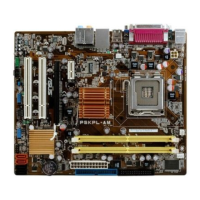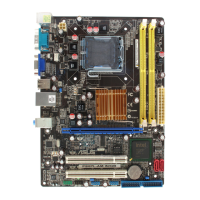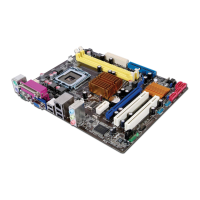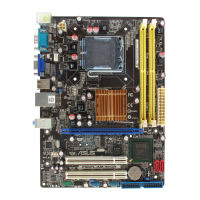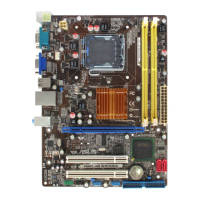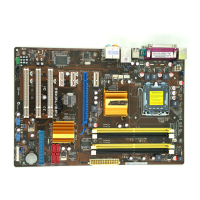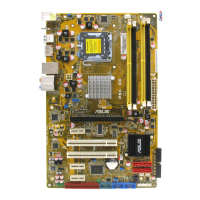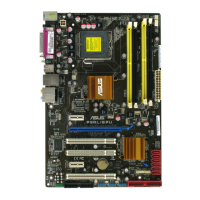Do you have a question about the Asus P5KPL-AM EPU and is the answer not in the manual?
Greeting and introduction to the motherboard.
Lists items included in the motherboard package.
Details key product features and specifications.
Describes proprietary ASUS technologies like EPU, Q-FAN, etc.
Provides essential precautions before installation and component handling.
Explains the function of the motherboard's standby power LED indicator.
Gives a general layout and component identification of the motherboard.
Explains correct orientation for motherboard installation into the chassis.
Details mounting points for securing the motherboard to the chassis.
Visual representation of motherboard components and connectors with numbering.
Enumerates and describes motherboard connectors, jumpers, and slots.
Covers CPU installation and related components.
Step-by-step guide for CPU installation into the LGA775 socket.
Instructions for mounting the CPU cooler assembly.
Procedure for safely removing the CPU cooler.
Information on memory installation and configurations.
Introduces the DDR2 DIMM sockets and their locations on the board.
Details compatible memory modules and installation guidelines for dual-channel.
Step-by-step instructions for installing RAM modules into sockets.
Guide for safely removing RAM modules from sockets.
Describes various expansion slots and their uses.
Process for installing expansion cards into available slots.
Steps for software configuration after installing an expansion card.
Information on PCI slot capabilities and supported cards.
Details on the PCI Express x1 slot and its uses.
Information on the PCI Express x16 slot for graphics cards.
Explains the function and configuration of motherboard jumpers.
Configures USB wake-up functionality from different sleep states.
Enables/disables keyboard wake-up feature using ATX power supply.
Details all motherboard connectors for peripherals and internal devices.
Describes ports on the motherboard's rear panel for external connections.
Details two 4-pin USB 2.0 ports for device connection.
Details two 4-pin USB 2.0 ports for device connection.
Describes the 15-pin VGA output port for monitors.
Describes the 9-pin serial COM1 port for pointing or serial devices.
Describes the PS/2 port for keyboard connection.
Describes internal motherboard connectors for system components.
Details fan connectors for CPU and chassis cooling systems.
Explains ATX power supply connections for motherboard and CPU.
Describes the digital audio output connector for S/PDIF module.
Details SATA connectors for connecting Serial ATA hard disk drives.
Describes the internal CD audio connector for stereo input.
Details the IDE connector for connecting legacy Ultra DMA drives.
Connects chassis front panel functions like power button, LEDs, and reset.
Connects the system warning speaker for beeps and alerts.
Connects internal USB headers to provide additional front panel USB ports.
Connects front panel audio jacks supporting HD Audio or AC'97.
Information on supported operating systems and bundled software.
Guidance on OS installation, including Windows XP/Vista.
Details contents of the support DVD, including drivers and utilities.
FCC compliance information and operating regulations.
Canadian compliance statement for digital apparatus.
Information on chemical compliance and product recycling guidelines.
General safety precautions for handling and operating the motherboard.
Safety guidelines related to electrical hazards and grounding.
Precautions during motherboard installation and operation.
Explains the purpose and organization of the user guide.
Outlines the structure of the user guide and its chapters.
Resources for additional product and software updates.
Explains symbols and typography used throughout the manual.
Defines text formatting conventions used for clarity.
Covers BIOS management, saving, and update procedures.
Details the ASUS Update software for BIOS management in Windows.
Explains the BIOS update utility accessible from within the BIOS.
Describes the BIOS recovery tool for corrupted BIOS files.
Guide to navigating and using the BIOS setup utility.
Overview of the BIOS setup interface elements and layout.
Explains the main menu options (Main, Advanced, Power, Boot, Tools, Exit) in BIOS.
Describes keys used for navigating the BIOS menus and changing settings.
Details the specific items available within each BIOS menu category.
Explains how to access submenus using the Enter key.
Describes how to view and change configurable BIOS settings.
Explains the use of pop-up windows for selecting configuration options.
Describes scroll bar usage for navigating BIOS screens with more options.
Explains the general help text provided in the BIOS interface.
Covers basic system information displayed upon entering BIOS setup.
Allows setting the system's current time within the BIOS.
Allows setting the system's current date within the BIOS.
Configuration and detection of IDE and SATA storage devices.
Settings for configuring SATA device parameters and modes.
Displays auto-detected BIOS, processor, and system memory specifications.
Covers advanced system settings for CPU and other devices.
Settings for CPU overclocking, frequency, and voltage adjustments.
Details CPU-related settings, including ratio, C1E, and thermal monitor.
Advanced chipset configuration options for North and South bridges.
Settings for managing integrated hardware like LAN, Audio, Serial, and Parallel ports.
Settings for USB functions, controllers, and legacy support.
Settings for PCI/PnP devices, including IRQ and DMA channel resources.
Settings for Advanced Power Management (APM) features.
Configures system sleep states (S1, S3) for power saving.
Enables additional tables for Advanced Configuration and Power Interface 2.0.
Enables ACPI APIC table support for interrupt handling.
Advanced power management settings like AC power loss restore and wake-up events.
Displays system hardware monitoring data, including temperatures, fan speeds, and voltages.
Configures system boot options and device priority.
Sets the sequence of boot devices for system startup.
Configures boot-related settings like Quick Boot and Full Screen Logo.
Manages system security settings, including supervisor and user passwords.
Accesses special utility functions for system management.
Utility for updating BIOS from within the BIOS interface.
Network cable checking utility performed during Power-On Self-Test.
Options for saving, discarding, or loading default BIOS settings.
| Form Factor | Micro ATX |
|---|---|
| Chipset | Intel G31 |
| Socket | LGA 775 |
| Maximum Memory | 4GB |
| Memory Type | DDR2 |
| Integrated Graphics | Intel GMA 3100 |
| Front Side Bus | 1600/1333/1066/800 MHz |
| PCI Express x1 | 2 |
| IDE | 1 x ATA100 |
| Audio Chipset | Realtek ALC662 |
| Audio Channels | 6 |
| PS/2 | 2 |
| Video Outputs | 1 x VGA |
| Memory Slots | 2 |
| Expansion Slots | 1 x PCI Express x16, 1 x PCI |
| Storage Interface | 4 x SATA 3Gb/s |
| LAN | 10/100 Mbps |
| Supported CPU | Intel Core 2 Quad, Core 2 Duo, Pentium, Celeron |
| Memory Standard | DDR2 800/667 MHz |
| LAN Speed | 10/100 Mbps |
| USB 2.0 | 8 x USB 2.0 |
| Audio Ports | 3 x Audio Jacks |
